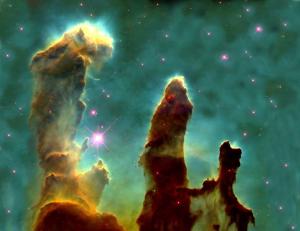Post
Pillars of Creation
30 September 2013
 J. Hester, P. Scowen (ASU), HST, NASA
J. Hester, P. Scowen (ASU), HST, NASAThe Pillars of Creation (seen above) is an image of a portion of the Eagle nebula (M16) taken by Hubble Space Telescope in 1995. It soon became one of the most iconic space images of all time. The Eagle nebula is a stellar nursery, with several regions of gas and dust where stars are actively forming, including the pillars.
It’s hard to fathom the true size of the pillars. What looks like an image of dark clouds is actually about 10 light years across. If you look for the reddish star in the right pillar, and move left until you reach a reddish star in the middle pillar, that is roughly the distance from the Sun to Alpha Centauri (about 4 light years). So these pillars would span a large region of our local neighborhood. Of course the Pillars of Creation is just one small section of the much larger Eagle nebula, which spans more than 100 light years.
The Eagle nebula is only about 7000 light years away, so we are able to get a good view of this region. We can see regions where stars are being formed, and regions where gas and dust are being pushed away by intense radiation. Because of this, the pillars are shifting, though on a very slow time scale. For example, images from the Spitzer infrared telescope hint at a high velocity shock wave (possibly from a supernova) heading toward the pillars. Given the speed shock wave, it will begin to disperse the pillars in another millennia or so.
Of course, since the pillars are 7000 light years away, that would mean the shock wave dispersed the pillars about 6000 years ago. So depending on your definition of “now” it’s likely that the pillars no longer exist.
When we look at images such as the Pillars of Creation, they seem to be constant and unchanging, but in fact nebulae change incredibly fast on the cosmic scale. Within a few million years, stars will have formed, the remaining dust and gas will have been dispersed, and the Eagle nebula will be no more.
We’ve simply captured a moment of stellar creation in a very big universe.